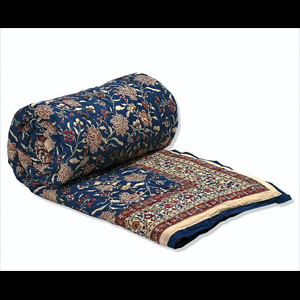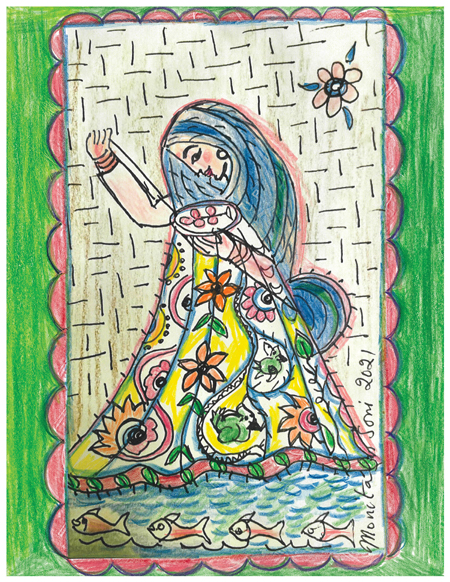Musings: The Quilt of Love

There was art, craft, heritage, and beauty in those soft and inviting cocoons of coziness... but above all, there was my mother’s love.
(Photo: Fabindia)
My mother, who grew up in Jaipur, was influenced by the culture of this well-planned city that has also been named a World Heritage Site. Historically, the city is said to have housed “chhattis karkhaanas” (36 industries) of handicrafts such as lac jewelry, stone idols, miniature paintings, quilt making, and more. My mother spent her early days enjoying the rich cultural and architectural beauty as well as the local arts and crafts of Jaipur. She learned to cook, knit, crochet, embroider, stitch, and sketch from the local artisans. She also learned the secret of quilting a perfect Jaipuri razaai.
Mother made several small razaais (quilts) for her family, and hand-stitched several pure white muslin lihaafs (covers) for them. She stored them in a huge fiveby- five feet galvanized iron trunk. Each family member had their own razaai with their initials embroidered on the edge of the cover. The heaviest one was my dad’s (it took all four of us to get it out of the trunk); then came my mother’s light and fluffy one, with an aroma of roses and jasmine; then mine, with blue birds; and my sister’s quilt with dolphins.
Our winter quilts were not filled with down like the comforters in America but with hand carded cotton. Raazais and kambals (blankets) were indispensable for a cozy and comfortable night’s sleep in the harsh winters of the northern plains in India. There was no central heating. To climb into a dear one’s warm razaai was a great privilege; to leave the comfort of one’s razaai, the biggest ordeal.
When we moved to the more temperate climes of our seaside home in Bombay, we opted for lightweight razaais that we bought from Jaipur. Jaipuri raazais are well-known for their craftsmanship, and rich and vibrant designs. Their display leaves buyers mesmerized. Handmade by local artisans, our razaais brought color, aesthetics, and heritage to our bedrooms. Mother carefully selected reversible screen-printed or block-printed quilts in vivid blues, terracotta, pinks, and mauves for all of us.
These razaais gave us a sense of comfort under the ceiling fans. We would wrap ourselves in the lightweight razaais like cocoons and sleep undisturbed. They were easy to hand wash and air dry. The spellbinding patterns retained their vibrancy with every wash. They could be stowed away in the compartment on the side of the bed and could be packed for travel in a backpack.
The secret of their airiness is in the process called cotton carding. As a kid, I would watch bales of cotton pass through two convex carder paddles equipped with small teeth. The cotton fibers were drawn across the face of the horizontal and vertical carder multiple times to separate the fine cotton from the waste. Only the soft and fine cotton fibers were evenly distributed in cotton voile—a lightweight, gauzy fabric that was silky and soft-to-touch like a baby’s cheek. Our Jaipuri quilts were made by hand as per ancient heritage.
On one of my trips to India, I fell asleep on my mother’s bed and had the best dreams ever. Upon waking, I told her I wanted something that would hold the warmth of my childhood. She smiled and ordered a special quilt for me— my own Jaipuri balaposh, like the one Nawab Shuja-ud-Din Muhammad had ordered. Soft like a pashmina shawl, comforting like a mother’s lap, and tender like a parijat blossom.
[Right] The author’s sketch of her mother making a quilt.
But it was my mother’s own quilt-making that fascinated me the most. First, she laid a blue Kashmiri silk saree on the floor, over which a layer of carded cotton fiber was placed. She then sprinkled attar, the essential oil, of peony and mogra; and then inserted a lightweight old blue Bombay Dyeing blanket (my dad’s). Another layer of a malmal saree with bulbul patterns was placed. Then a final layer of silk sealed the deal. Mother added a few widely spaced stitches herself, then gave it to the artisan to finish the quilt.
The razaai was edged with a broad silk ribbon in pomegranate pink. When I was due to return to America, she packed my soft silk razaai in a perfumed box. Mother also gave some more of them as gifts for my friends in America. I may not be Mallika Nur Jehan but my mother made me feel like one. My quilt of love is an heirloom piece. It’s the best Christmas present. It keeps me warm in winter and feels cool to the touch in summer. When I think of my mother, I find my arms reaching for my razaai, and I cover myself in the quilt of her kindness. Eternal like her love for all of us.
With one foot in Huntsville in Alabama, the other in her birth home India, and a heart steeped in humanity, writing is a contemplative practice for Monita Soni. She has published hundreds of poems, movie reviews, book critiques, and essays; and has contributed to combined literary works. Her two books are My Light Reflections and Flow through My Heart. You can hear her commentaries on Sundial Writers Corner WLRH 89.3FM and the Princess Theater.
Enjoyed reading Khabar magazine? Subscribe to Khabar and get a full digital copy of this Indian-American community magazine.
blog comments powered by Disqus










